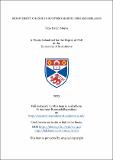Files in this item
Biodiversity change in Scottish marine fish assemblages
Item metadata
| dc.contributor.advisor | Magurran, Anne E. | |
| dc.contributor.author | Moyes, Faye Helen | |
| dc.coverage.spatial | 252 | en_US |
| dc.date.accessioned | 2023-05-11T13:04:09Z | |
| dc.date.available | 2023-05-11T13:04:09Z | |
| dc.date.issued | 2023-06-14 | |
| dc.identifier.uri | https://hdl.handle.net/10023/27571 | |
| dc.description.abstract | Marine fish are an irreplaceable natural resource but are currently under threat due to anthropogenic pressures. To date, most of the emphasis has been on single stocks or populations of economic importance. However, commercially valuable marine fish are embedded in assemblages of many species and there is only limited understanding of the extent to which the structure of whole communities has altered in recent years. Research suggests that recent years have seen rapid compositional and reorganisation of marine assemblages but how these taxonomic changes are related to functional diversity is less evident. Biodiversity is multifaceted but fisheries science has historically focused mainly on taxonomic diversity, for example, by taking species abundance combined with mortality rates to produce an estimate of stock size. This thesis fills a gap in marine fisheries research by using a range of different metrics to help understand diversity change in the whole assemblage from both a taxonomic and a functional perspective, and by identifying influential species in compositional change. This thesis aims to quantify how two geographically close, but distinct ecosystems from around the Scottish coast (part of the Celtic-Biscay shelf region on the west and the North Sea region on the east), have changed over a thirty-year time frame by utilising two facets of biodiversity and analysing at a whole assemblage level. The consistent nature of the scientific trawl surveys that form the basis for this work give an ideal study system for the analysis undertaken. Moreover, the statistical bounding areas provided by the ICES rectangles allow sample-based rarefaction and enable fair comparisons between systems and latitudes. My main hypothesis is that despite the distinctions between coastal systems, their geographic proximity and similarity of species will lead to no clear difference in diversity change. This thesis will examine this biodiversity change in four main ways: spatio-temporal change in taxonomic diversity; spatio-temporal change in functional diversity; spatio-temporal change in rarity; and identification of influential species within the systems. My results clearly indicate that it is possible to reject the null hypothesis of no difference between systems. I find contrasting patterns between the coastal systems when examining trends in both taxonomic and functional diversity, in addition to key differences between those species most influential in contributing to compositional change and the types of contributions they make. I also examine trends in rarity to ask how the different dimensions covary over time and find that the direction of temporal shifts in taxonomic rarity is consistent with a null model of change in assemblage size. However, the observed data depart from the null expectation of a decrease in functional rarity suggesting that the functional integrity of the systems is maintained, even when assemblage size increases. Gaining an understanding of the reorganisation of assemblages based on the shared dynamics of the species within them can aid with the monitoring and restoring of biodiversity. These results underline the importance of measuring both taxonomic and functional dimensions of diversity when assessing and interpreting biodiversity change. A multidimensional, integrated approach to biodiversity assessments, as undertaken here, has an important role to play in the ecosystem-based management of fisheries. This thesis fills a gap in the current knowledge regarding biodiversity monitoring of fisheries data and as such is of potential importance to policy makers and managers. | en_US |
| dc.language.iso | en | en_US |
| dc.relation | Biodiversity change in Scottish marine fish assemblages (thesis data), Moyes, F. H., University of St Andrews, 14 Jun 2023. DOI: https://doi.org/10.17630/d4c3ab21-b14b-4365-8d67-c27c998e5a29 | |
| dc.relation | ||
| dc.relation | Moyes, F. H., Trindade Santos, I., & Magurran, A. (2023). Temporal change in functional rarity in marine fish assemblages. Proceedings of the Royal Society B: Biological Sciences, 290(1993). https://doi.org/10.1098/rspb.2022.2273 | |
| dc.relation | ||
| dc.relation | Moyes, F., & Magurran, A. E. (2019). Change in the dominance structure of two marine-fish assemblages over three decades. Journal of Fish Biology, 94(1), 96-102. https://doi.org/10.1111/jfb.13868 [Open access version: https://hdl.handle.net/10023/19170] | |
| dc.relation.uri | https://doi.org/10.17630/d4c3ab21-b14b-4365-8d67-c27c998e5a29 | |
| dc.relation.uri | https://doi.org/10.1098/rspb.2022.2273 | |
| dc.relation.uri | https://hdl.handle.net/10023/19170 | |
| dc.subject | Marine fish | en_US |
| dc.subject | Biodiversity | en_US |
| dc.subject | Scotland | en_US |
| dc.title | Biodiversity change in Scottish marine fish assemblages | en_US |
| dc.type | Thesis | en_US |
| dc.type.qualificationlevel | Doctoral | en_US |
| dc.type.qualificationname | PhD Doctor of Philosophy | en_US |
| dc.publisher.institution | The University of St Andrews | en_US |
| dc.identifier.doi | https://doi.org/10.17630/sta/441 |
This item appears in the following Collection(s)
Items in the St Andrews Research Repository are protected by copyright, with all rights reserved, unless otherwise indicated.

